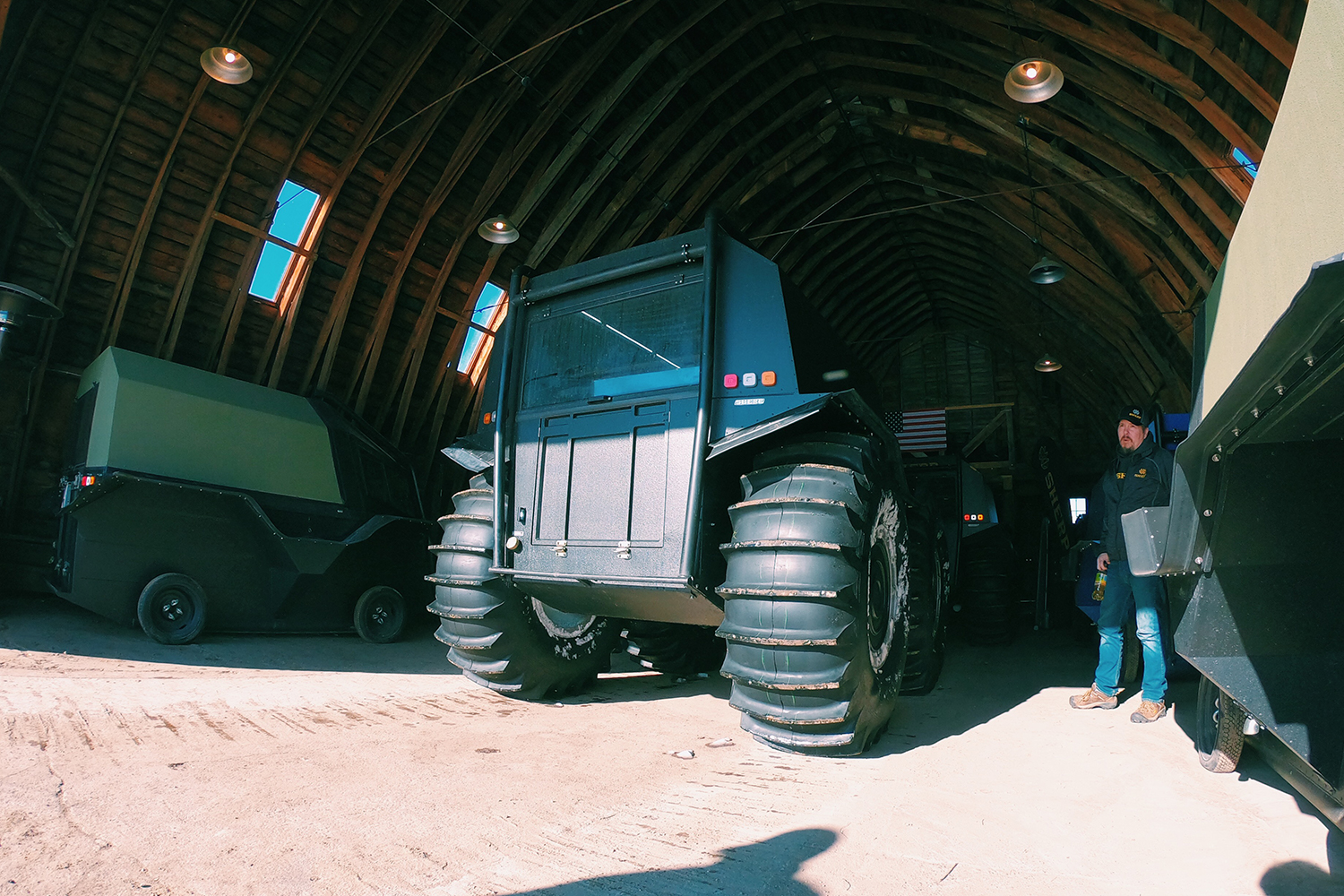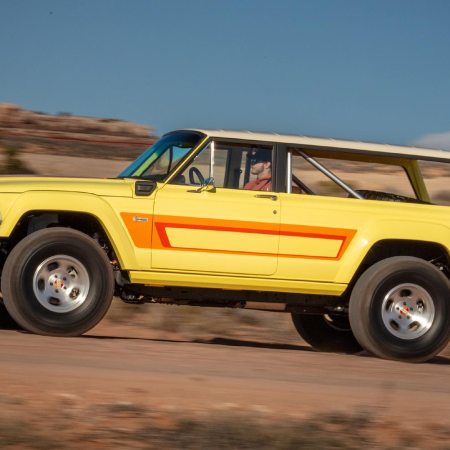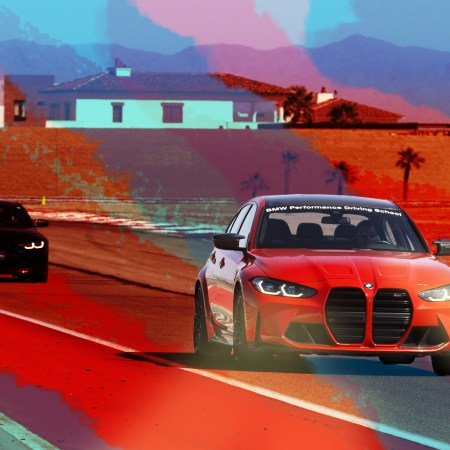Want to know if an off-road vehicle is any good? Just ask a young guy with a lifted truck.
There’s no way in hell a kid from rural U.S.A. who has put his entire life savings into a jacked-up Ford F-250 with 40-inch tires is going to say your vehicle is better than his, unless it is positively, absolutely, unequivocally the king of off-roading. So when Minnesotan Cullen Copiskey casually mocked his pickup in front of me, I knew I was in for a treat.
“I always think, my truck would be so stuck or flipped right now. There’s no way my mud truck could do this, and it just does it like nothing,” he said.
The it in question, the king of off-roading, is called Sherp. Or should we say the tsar of off-roading?
You see, Sherp is a mysterious, amphibious, all-terrain vehicle that was born in a garage in Russia and eventually made its way into not one, but two Kanye West music videos late last year (“Follow God” and “Closed on Sunday”). We at InsideHook covered it as early as 2017, and chances are you’ve seen it crashing through an ice-covered lake and staying afloat in one of the dozens of viral YouTube or Instagram videos that have propelled it to internet fame. And despite Sherp garnering blurbs in glossy magazines and starring turns on multiple web series, no one seems to answer the most important questions — chiefly, where and how do you get one of these in the U.S.?
For the answer, we drove all the way to Sherp USA, the first, largest and most prestigious dealer in the country, located in Bemidji, Minnesota. There, we spent the day with owner Joshua Copiskey and his son Cullen, who has taken up what seems to be the best family business imaginable. Not only did the father-son duo have a dozen of the off-road behemoths on site, that site itself is a 500-acre proving ground in the middle of farm country featuring every obstacle imaginable.

“We’ve got boulders, bottomless swamp, a private lake, floating bog. We’ve crushed cars. We’ve run over trees. Search and rescue will come here to do their training because they know they can do everything here that they could experience in the field,” said Joshua. If you try to Google Maps Sherp USA to get a firsthand look at their setup, you won’t find the real location — they’re intentionally unlisted because anonymity is part of the reason potential buyers come to them (that, and the fact that there’s an airport 15 minutes away that accepts private jets).
After all, Kanye got his 10 Sherps from the Copiskeys, no matter what The New York Times says.
“The problem was when we first started, no one knew what a Sherp was,” said Cullen. “Now you can actually get them in the U.S. and people like Kanye are getting Sherps, and people are realizing what they are and that you can actually buy them.”
“We were out at his [Wyoming] ranch,” added Joshua. “We spent time out there training him how to drive.”
They didn’t say how, exactly, Kanye discovered Sherp, but despite their dealership being in the U.S. for three years, the elder Copiskey said “15 minutes on YouTube” is the main way clients discover the vehicles. In fact, that’s how he came to open Sherp USA.
“Off-road has always been a part of our lives,” said Copiskey, adding that he owns two military Humvees and his son has a YouTube channel, UpNorthOutdoors, mostly devoted to the topic. “When he was younger, I’d scroll through the comments [on his channel], make sure he’s not getting some stalker or something, and I saw this crazy big-wheeled thing on the sidebar. I was like, what the heck is that?”
That led him to search the internet for more information about Sherp, but he couldn’t find anything in English. Eventually, he found the original website. “It was all Russian. I couldn’t understand it. I just typed in, ‘English?’” he explained. “About an hour later — I forgot all about it — the chat box popped up in my screen and said, ‘Good evening.’ I was like, ‘Whoa, I’m talking to a Russian.’”
To be clear, the vehicles sold in the U.S. are officially from Ukraine, but the history begins in Russia with DIY engineer Alexei Garagashyan, who built the first version of the amphibious ORV to win an off-road competition. According to Copiskey, it “caught the eye of a Russian oligarch and a Ukrainian billionaire” who bought into it and are now bringing Sherp to the rest of the world. Since the official mass-market introduction of Sherp in 2015, they’ve driven in some of the most hostile conditions on earth, including a 6,200-mile trip across Russia without using roads. Now they’re finally finding a market among professionals: Sherp USA has sold units to sheriff’s departments and search-and-rescue organizations across the country.
I’ve got two military Humvees and those were the most capable off-road vehicle on the planet. Sherp makes them look like front-wheel drive cars.
Joshua Copiskey, Sherp USA dealer
When we took a Sherp Pro model for a spin around the Copiskeys’ snow-covered grounds, it was easy to see the ORV’s appeal to its various clientele, from aid groups looking to save lives to wealthy doomsday preppers. (When I asked if they get any of those latter types, Copsikey said, “Some.”)
Sitting in the two-person cockpit with jump seats in the back was akin to amusement-park simulators or movie theaters with moving seats — it’s inevitable you’ll get jostled around when climbing impossible inclines, rolling over boulders and mowing down small trees, but it’s a comfortable jostling where you never doubt for a second that you’ll make it through unscathed.
Like any off-road vehicle, there are many features to tout, from the sealed body (allowing for the aforementioned water access) to the super-low fuel consumption to the ability to sleep four people and carry 2,000 lbs. while weighing under 3,000 lbs. itself. But what makes it a Sherp, and why one search-and-rescue team said to Copiskey that the Sherp would replace 90 percent of its vehicles, comes down to one thing: the tires.

They look borrowed from a tractor or Tonka Truck, but in reality they’re proprietary, tubeless, ultra-low-pressure tires that use the exhaust to rapidly inflate and deflate so the driver can calibrate them to the specific terrain in seconds, and also use the protruding ridges as paddles to move in the water. (Apart from the dramatic ability to break-through ice on frozen lakes and rivers, the Sherp can also be registered as a boat in the summer). When driving through the snow, ice and dirt, Copiskey steered via two levers with his left hand and changed tire pressure with the other — if you know how to drive a stick shift, it’s simple, and if you don’t, it’s an easy learning curve.
While Sherp is confident there is nothing like it on the market — in the U.S. or anywhere else — the company is still improving. A new 2020 model was revealed this month, and while specs will be unveiled soon, Copiskey let a few details slip, notably that it’ll have even bigger tires, more horsepower, 30 percent more cabin volume and the ability to carry 10 people. It continues the company’s trend toward a bigger-is-better mindset, which started with last year’s release of the Ark, which is basically a Sherp trailer. Copiskey didn’t have any of them in stock, but he has sold a couple.
If you’d like to buy one yourself, Copiskey explained that it’s much easier than clients imagine.
“If you came in here right now and said, ‘I want to buy one,’ I can put one on a trailer and you could leave — if you had a pickup — with it on the spot,” he said. “We’ve had clients bring in literally sacks of cash and just drop it down.”

That’s not the majority, mind you, since these start around $105,000 for the Sherp Pickup and $110,000 for the Sherp Pro. That includes delivery to your doorstep (you don’t actually have to BYO pickup) and a full day of driver’s training, as well as warranty repairs. If you have a mechanic you want to train on the vehicles — say if you bought a fleet for your business — they’ll coordinate that. Plus, the service is better than you’re likely to find at your local ATV dealer.
“Every client also receives three cell-phone numbers,” said Copiskey. “Service, inside sales and manager. These cell phones will always be answered 24-7 to help our clients. I alone have been called at 3 a.m. by search-and-rescue organizations with operation questions. We realize that our clients don’t just drive their units Monday to Friday 8 a.m. to 5 p.m. CST.”
When I asked Copiskey about their clients, specifically the profile of a typical Sherp buyer, he put it succinctly: “It’s predominantly right-wing, conservative, gun-owning men.” That’s part of the reason why the hats he and his son were wearing were stitched with the phrase “For Courageous Men.”
When his dad mentioned that, Cullen spoke up, saying that they have hats that read “For Courageous Women,” too. But no women have bought a Sherp from them yet.
This article was featured in the InsideHook newsletter. Sign up now.






















